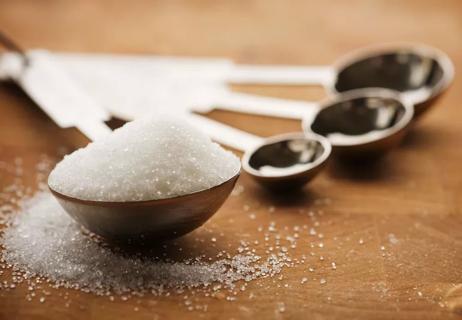You can reduce how much added sugar you consume by tracking what you eat, reading labels and limiting portions of the sweet stuff

Limiting sugar intake is important for your overall health. Too much added sugar can increase your risk of Type 2 diabetes, heart disease and obesity.
Advertisement
Cleveland Clinic is a non-profit academic medical center. Advertising on our site helps support our mission. We do not endorse non-Cleveland Clinic products or services. Policy
But how many grams of sugar per day is OK? Registered dietitian Beth Czerwony, RD, LD, discusses how much sugar is too much and ways to cut down.
What we’re really worried about are added sugars. Added sugars are sweeteners that are added to foods while they’re being processed and prepared.
Current U.S. government dietary guidelines recommend keeping added sugars to less than 10% of your daily caloric intake. So, if you consume 2,000 calories a day, no more than 200 of those calories should come from added sugar.
Those 200 calories equal 12 teaspoons (48 grams) of added sugar. To put it in perspective, a single can of soda may contain a full day’s worth of added sugar.
Additionally, the American Heart Association advises consuming even less. It recommends no more than:
We know that added sugar can be tough to avoid. Researchers scanning American grocery shelves found that 68% of barcoded food contained added sweeteners. That’s more than 2 out of 3 items in the average cart.
Sugar isn’t just “added” to foods. In some cases, such as fruit and dairy milk, sugar is just there naturally. So, why isn’t that a big worry?
Advertisement
“Your body typically handles natural sugars better than sugar added to food as a sweetener,” explains Czerwony. “Plus, many of the foods with natural sugar offer other nutritional benefits that aren’t in processed foods.”
So, while a banana or glass of milk may be high in sugar, other vitamins and nutrients help offset that dose of sweet. You’re also less likely to overdo it on fruit or milk than you are to annihilate a bag of cookies.
Eating added sugar increases your risk of:
If you’re worried about eating too much sugary food, try these tips:
Want to know how much sugar you’re consuming a day? The best way to figure that out is to keep track of what you eat and how much added sugar those items have. Understanding where your added sugar is coming from is the first step to reducing the amount. Sometimes, cutting back on one or two items can make a significant change.
“Using an online or phone app is an easy way to track your intake, especially any added sugar in your diet,” says Czerwony. “Many options allow for manual input or taking a picture of a product’s barcode, which makes it user-friendly.”
Packaged foods and drinks have a designated spot on their labels for added sugar.
This information includes the amount of added sugar per serving in the food product, as well as how that fits (% daily value) within a 2,000-calorie diet.
“Looking at the label is important if you want to manage sugar intake,” says Czerwony. “You’ll probably be surprised at the amount of added sugar in food where you really don’t expect to find it.”
A good rule of thumb is to try to avoid foods and drinks that have 10 grams or more of added sugar.
“Keeping that number in the single digits can keep your total from jumping too high,” she notes.
Added sugar goes by many names on ingredient lists, shares Czerwony. Aliases include:
If you’ve got a hankering for something sugary, limit your portions to help satisfy that craving. Try to eat one doughnut instead of two when the urge strikes.
“If you’re craving something sweet, it’s important to eat it closer to a meal or with a protein source, if available. This helps avoid blood sugar spikes, which can lead to more fluctuations, causing more cravings or larger portions,” explains Czerwony.
Advertisement
“It’s also important to mindfully eat your treat sitting down so you can focus on what you’re eating. Actually tasting the food will help you eat less and allow your brain to register that you have been fed.”
It’s easy to look at candy and know it’s a sugary food. Ditto for dessert table delights like cakes and cookies. Nobody’s going to be surprised to see ooey-gooey ice cream on the list either.
But certain varieties of foods actually have gobs of added sugar — and that’s really not good for you. Examples include:
While it makes food taste delicious, added sugar doesn’t benefit your health.
It can be challenging to give up sugar completely, but you can make smarter choices to help reduce how much sugar you’re consuming, encourages Czerwony.
The overall goal is to eat a balanced diet, which can keep you on track with wellness goals. If you skip meals or your diet is lacking in nutrition, your body may crave sugar as a quick pick-me-up.
“If you’re filling up on fruits, vegetables and lean proteins, odds are, you won’t go looking for the sugary treat later,” she says.
Advertisement
Advertisement
Learn more about our editorial process.
Advertisement

A high-sugar diet can trigger a chain reaction that may raise your risk

A high intake of sugar can cause an increase in ‘bad’ cholesterol and a decrease in ‘good’ cholesterol

Often labeled as ‘diabetes-friendly’ or ‘calorie-free,’ these sugar substitutes warrant caution

There is an indirect link between the sweet substance and the condition

It’s touted as a healthier alternative to cane sugar, but basically, well ... it’s still just sugar

Sugary foods don’t always taste sweet, and they may not say ‘sugar’ on the label

Don’t skip meals or go ‘cold turkey’ — eat a balanced diet and talk to your doctor instead

Fuel your body with healthy options that combine fiber-rich carbs, lean protein and healthy fats

Start having sex about 72 hours before ovulation, then at least every other day during your fertile window

Attachment theory suggests that your earliest relationships shape connections throughout your life

It isn’t a recognized mental health disorder, but research shows that problematic social media use can negatively affect your mental health, self-esteem and sleep